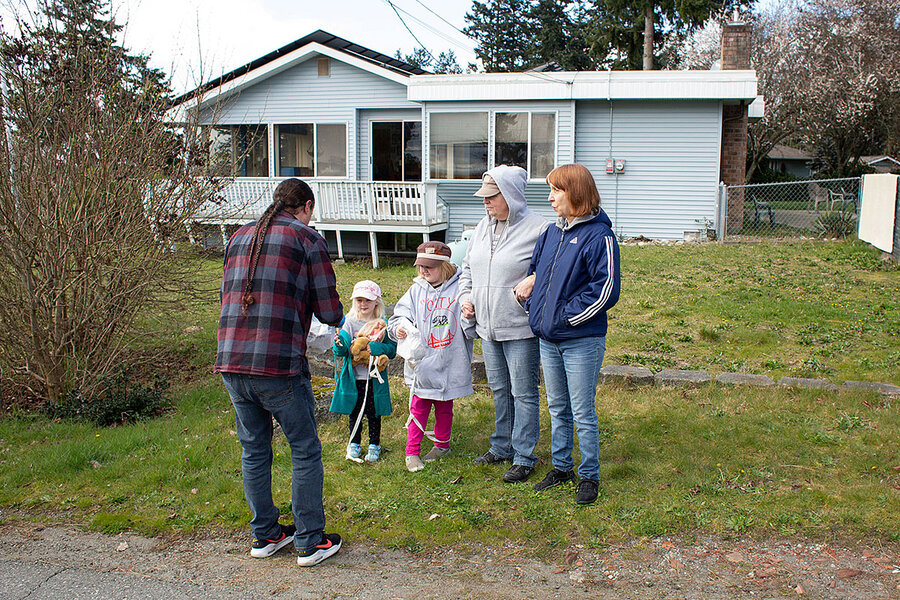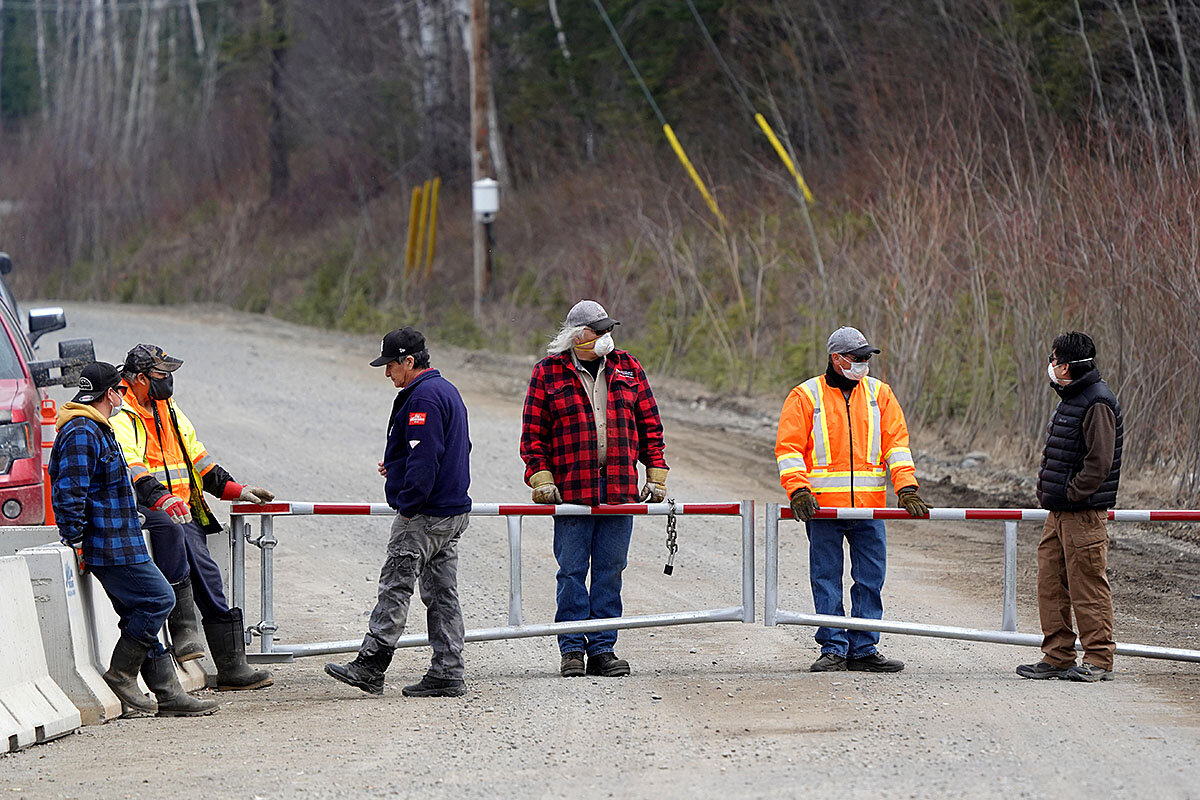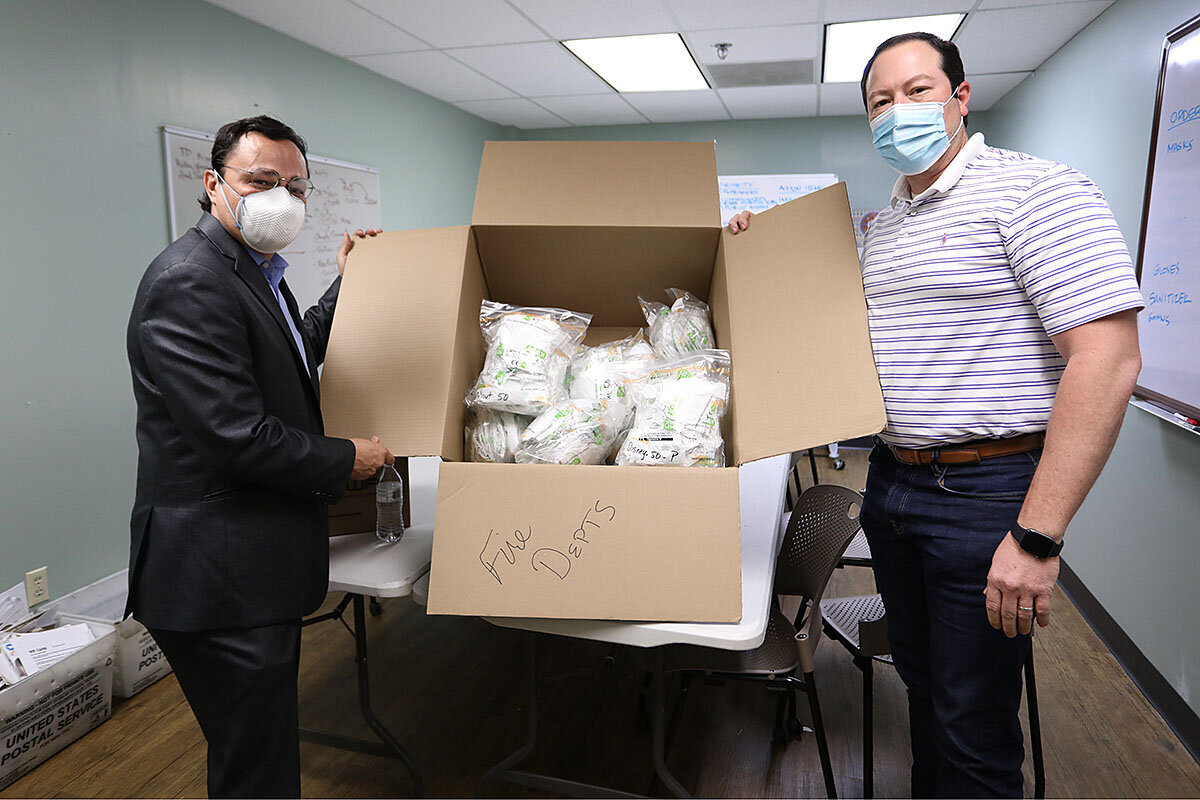For Native Americans, coronavirus looks heartbreakingly familiar
| Austin, Texas; and Toronto
For the first North Americans, memories of pandemics are long.
Lela Oman was an infant in Nome, Alaska, during the 1918 flu epidemic. Nome, on the far northwestern tip of the continent, had just gotten a telephone line, so residents were able to get some advance warning.
Everyone knew what to do after that, Ms. Oman recalled in a 1996 interview for a University of Alaska, Fairbanks, oral history project. Dog teams “went to Deering and to Shishmaref telling everybody up there not to come down,” she said. “At Shishmaref, there were guards, sentries, with guns. If anybody started coming up this way, shoot to kill.”
Why We Wrote This
Perhaps no community in North America has been more shaped by infectious disease than Native tribes. Overcoming today’s crisis means turning to deep wells of resilience.
Editor’s note: As a public service, all our coronavirus coverage is free. No paywall.
Those responses from a century ago are playing out again now as Native communities across North America go on the offensive against COVID-19. Infectious diseases have played a tragic role in the history of indigenous people on the continent, from smallpox to the measles wiping out large swaths of the population through the centuries.
Now, with the arrival of the new coronavirus, Native communities face severe challenges. Those on reservations are disproportionately old, have high rates of chronic disease, are often living in remote locations, and rely on dramatically underresourced health systems. What’s more, for some Native tribes, older people are the last repositories of vanishing languages and cultures.
“Every [issue] that is true elsewhere in the United States is being magnified” in Indian Country, says Allison Barlow, director of the Johns Hopkins Center for American Indian Health.
As recently as the 1918 flu epidemic, the death rate for Native communities in the U.S. was four times higher than the nation as a whole. That shared past has pushed some Native communities to act faster than their neighboring state and national governments, reprising the same shutdowns and security patrols from a century ago. But it has also added something more – a remarkable perseverance.
“This has in many ways been a perfect storm” for Native communities, says Dr. Barlow. But in Native populations, “there’s incredible resilience and flexibility.”
The scope of the challenge
A lack of testing is a problem for the entire continent, but it’s an additional problem for Native communities and health systems that were already stressed. That has made it hard to get an accurate gauge of the coronavirus’s impact.
There are 2,711 confirmed cases in the U.S. Indian health system, and 89 deaths, as of Tuesday, according to an Indian Country Today database. And as of Wednesday, Indigenous Services Canada was aware of 129 confirmed positive tests on First Nations reserves. Those numbers may not capture the large indigenous population living off reservations.
Yet reservations are the greatest cause for concern. While the majority of indigenous people live outside reservations, reservation demographics skew toward the most vulnerable populations, including older people and those with chronic illnesses. Most positive cases in Indian Country are concentrated in a few reservations.
Moreover, reservations struggle with a host of challenges. Health facilities are understaffed and underresourced. Homes are crowded, with several generations under one roof. Infrastructure is poor, and in some cases nonexistent. One in three people in the Navajo Nation don’t have running water, for example, according to the Navajo Water Project. In Canada, some reserves not only lack water but also have a “do not use” advisory in effect, meaning they can’t even use that water for hand-washing.
Many reservations are also remote, and that isolation can cut both ways. Ninety-six First Nations in Canada can be reached only by plane, while in Alaska, essential air services that carry food, freight, and mail have been reduced dramatically.
The Canadian government has sent hand sanitizer, masks, gloves, and isolation shields to indigenous communities and is deploying the Canadian Rangers to Inuit communities in northern Quebec. The U.S. Congress, meanwhile, has passed four national relief packages that include more than $8 billion for Indian Country.
But that comes after decades of underfunding from national governments that, through treaty agreements, have a trust responsibility to provide health care to tribes.
Take the Pine Ridge Reservation in South Dakota and Nebraska. There is one inpatient health care facility on the reservation, which has a population of almost 20,000 and is more than twice the size of Rhode Island. The clinic has 45 beds and 16 staff members, according to the Indian Health Service.
More supplies are being ordered, and the tribe has a contingency plan for two large-scale quarantine sites. The echoes of the past are hard to ignore.
“This situation is retraumatizing to many tribal communities,” says Dr. Barlow at Johns Hopkins.
“After they have rebounded from generations of genocide and ethnocide and really started to develop autonomous structures for governing and so forth,” she adds, they’re “being revisited by an old enemy. Here is this deadly virus, and they don’t have what they need to contain it.”
Defending the reservation
So tribes are taking matters into their own hands as best they can.
Since the evening of April 3, for instance, the Oglala Sioux have been enforcing a curfew on the Pine Ridge Reservation, restricting who can enter. (Neither South Dakota nor Nebraska has issued statewide lockdown orders.) The tribe has been educating members on hand-washing, including drawing up posters in various languages.
“Are we ready as a people?” asked Julian Bear Runner, president of the tribe, in an April 1 Facebook Live video. “We’re getting ready. I think we’re as ready as we can be right now.”
The Little Pine Nation is taking similar steps. A Cree First Nation in northwest Saskatchewan, the Little Pine Nation has 2,000 members. The reserve sits in a valley with two main roads in and out. The Nation runs its own security force, and members say they began patrolling – allowing only residents and essential travel in and out – as soon as the province closed major services on March 25.
Little Pine has also closed schools and organized the distribution of food and supplies. Doug Cuthand, a local columnist and filmmaker, says he’s never seen anything like it.
“It seems to be a total community effort to try and stop this thing,” he says. “Because there is a fear that if it does get a foothold ... it could be very dangerous.”
Care for elders
One of the deepest concerns is for tribal elders. Elders are revered in indigenous communities as the carriers of knowledge, tradition, and language. And tribes around the continent have been taking extra care of them.
Since mid-March, the Cherokee Nation has delivered food to elders across the reservation – including perishable items from 10 casinos and hotels the tribe shut down. Tribal members have also been visiting elders in person to instruct them, in Cherokee, how to follow health and safety guidelines.
The Cherokee Nation is the largest tribe in America, but only 2,000 of its 380,000 members are fluent Cherokee speakers, according to Chuck Hoskin Jr., principal chief of the Nation.
The “lion’s share” of them are age 65 or older, he says. “They’re the keepers of our stories and our history.”
“They’re holders of [our] ingenuity and knowledge,” adds Dalee Sambo Dorough, chair of the Inuit Circumpolar Council. “The lessons that they share, that they’re eager to ensure that others heed – especially when it comes to hunting, fishing, harvesting, and our overall food security” – are crucial.
It was only in 1925, after all, that a serum was rushed by a dog team to Nome to prevent a diphtheria outbreak – a crisis that inspired the Iditarod race.
“For many of our leaders, the epidemics of the past [are] recent history,” Dr. Dorough adds.
In that way, this crisis feels familiar. John Borrows, a member of the Chippewas of Nawash First Nation in southern Ontario, wrote last month about how infectious diseases left a mark on his mother’s childhood.
“That kind of telescopes then to what happened in the previous generation with the Spanish flu and what her father experienced, and then that telescopes back to the previous generation with smallpox and what her great-grandfather experienced,” says Mr. Borrows, an expert in indigenous law at the University of Victoria Law School in British Columbia. “So it cascades and it gets wrapped together for folks – that smallpox is Spanish flu is tuberculosis is COVID-19.”
Today, his mother’s reservation is organizing supplies and food distribution for the neediest people. She gets soup delivered to her front door every evening.
“Sometimes people view reserves as just a lost cause of problems,” he says. “But they’re also homelands, and people love them.”
Little Pine’s Mr. Cuthand says his community’s quick response comes from the knowledge of what past pandemics have done to First Nations communities. What inspires hope is “the fact that [First Nations] are so disciplined.”
If anything, Native communities can take pride in how they’ve responded to the COVID-19 pandemic so far, says Jessica Elm, a postdoctoral fellow at the Johns Hopkins Center for American Indian Health.
“In some ways I feel we’re doing better than a lot of people in this current situation,” says Dr. Elm, a member of the Oneida Nation in northern Wisconsin. “Tribal communities are resilient to this. ... We’ve been through it before. We know our ancestors have got through it, so we know we can get through it.”
Correction: This article has been corrected to accurately state the number of Navajo without running water.
Editor’s note: As a public service, all our coronavirus coverage is free. No paywall. Also, the story has been updated to include the correct number of Cherokee Nation members.







